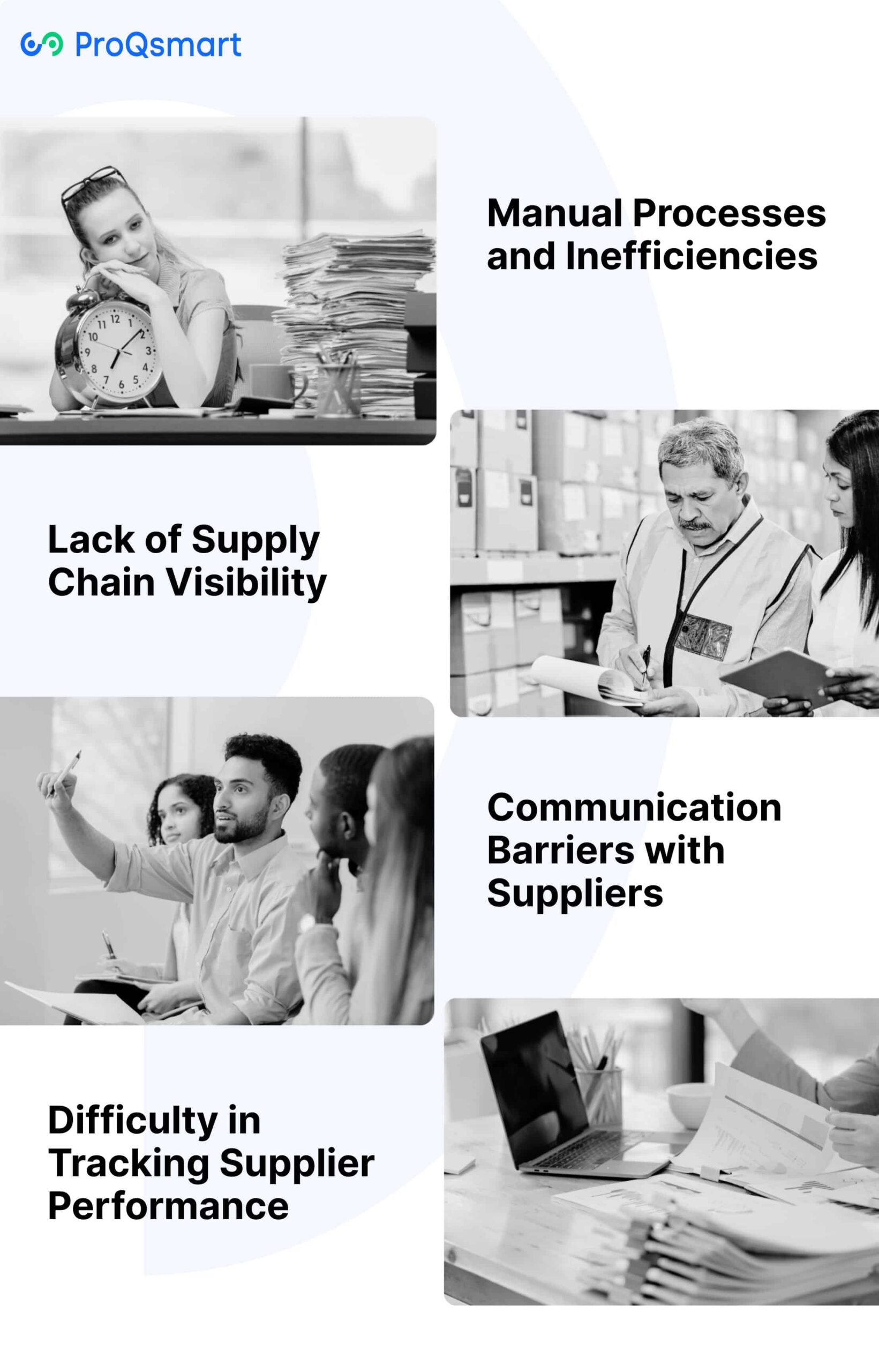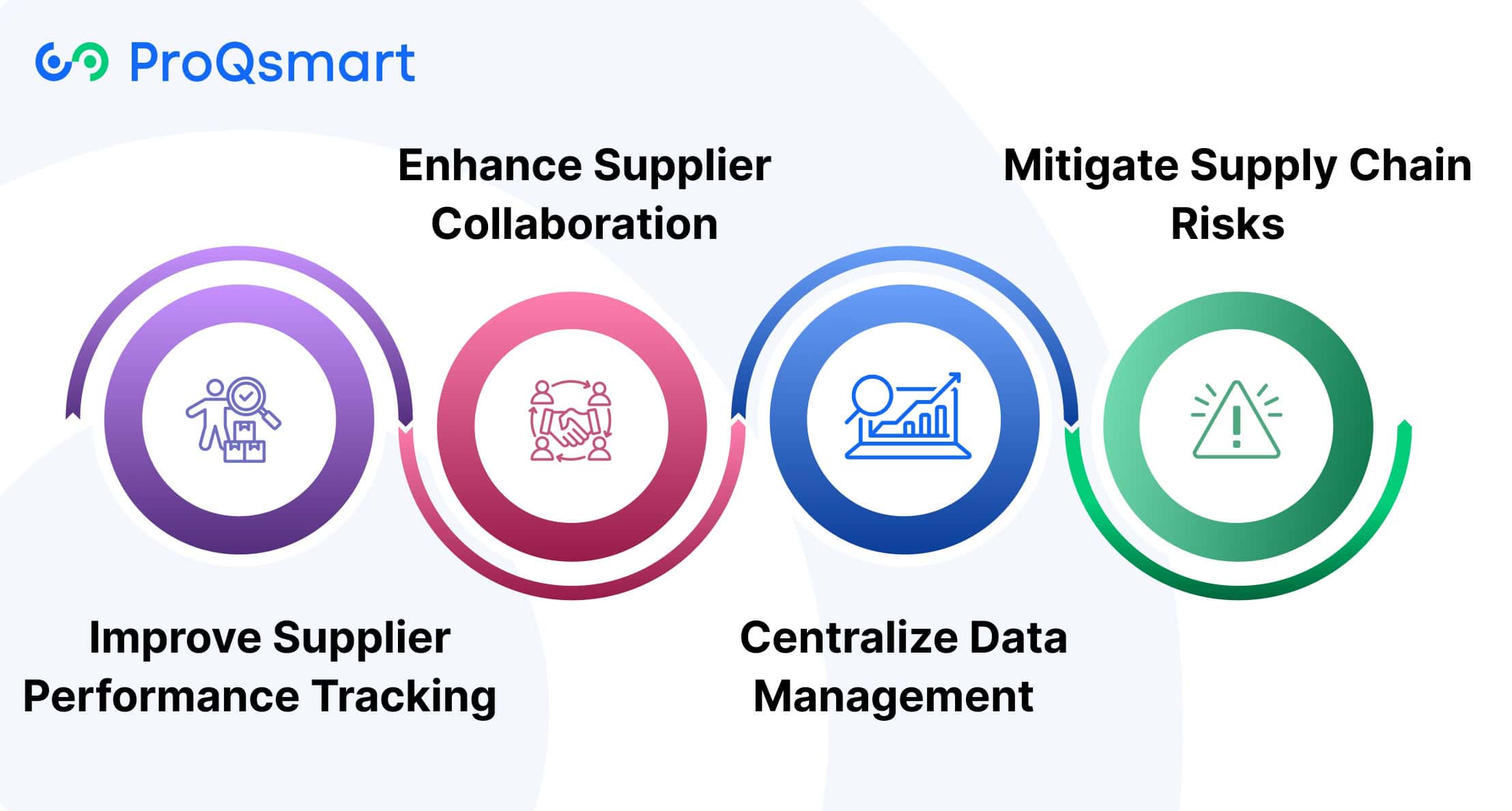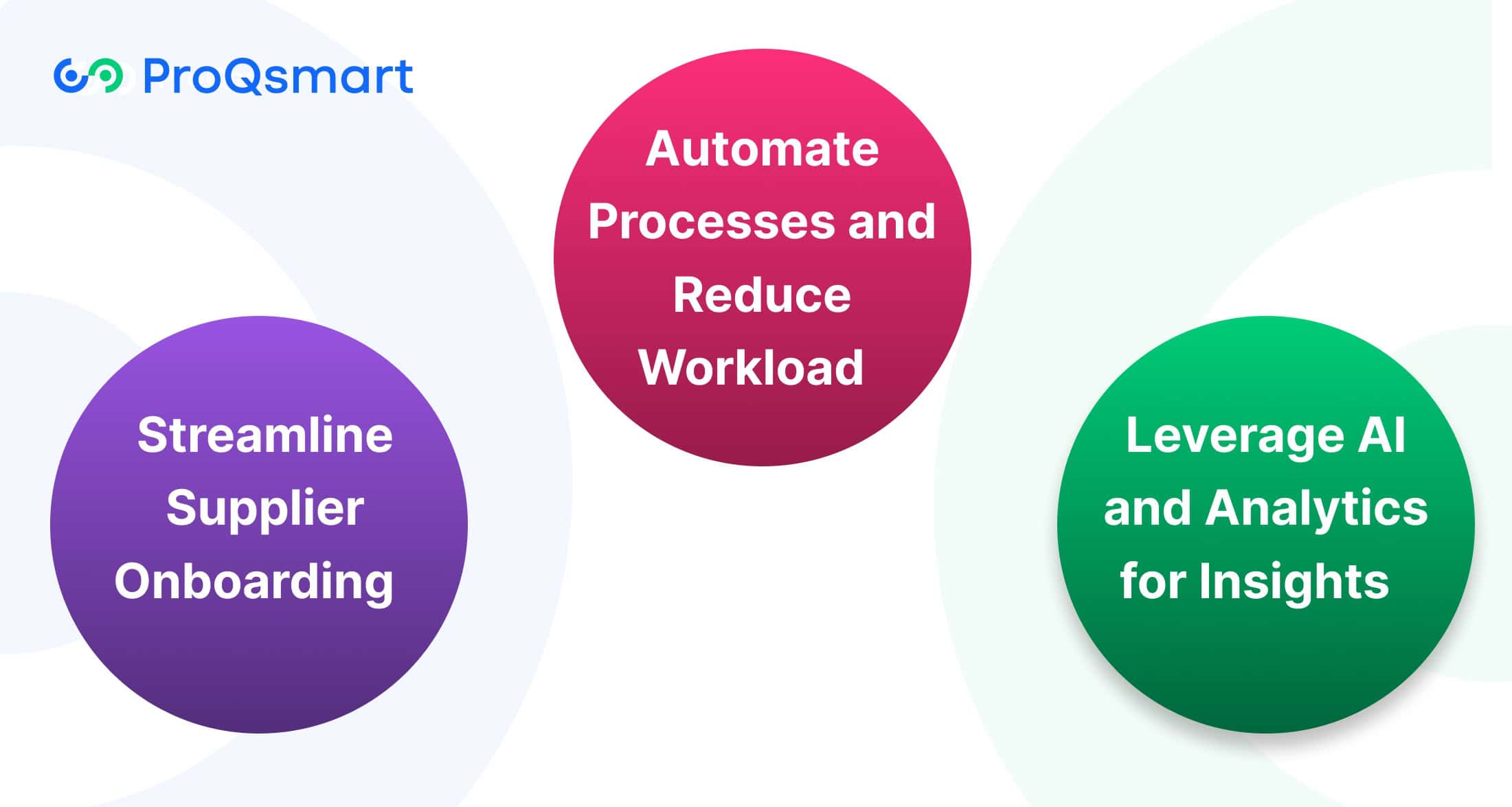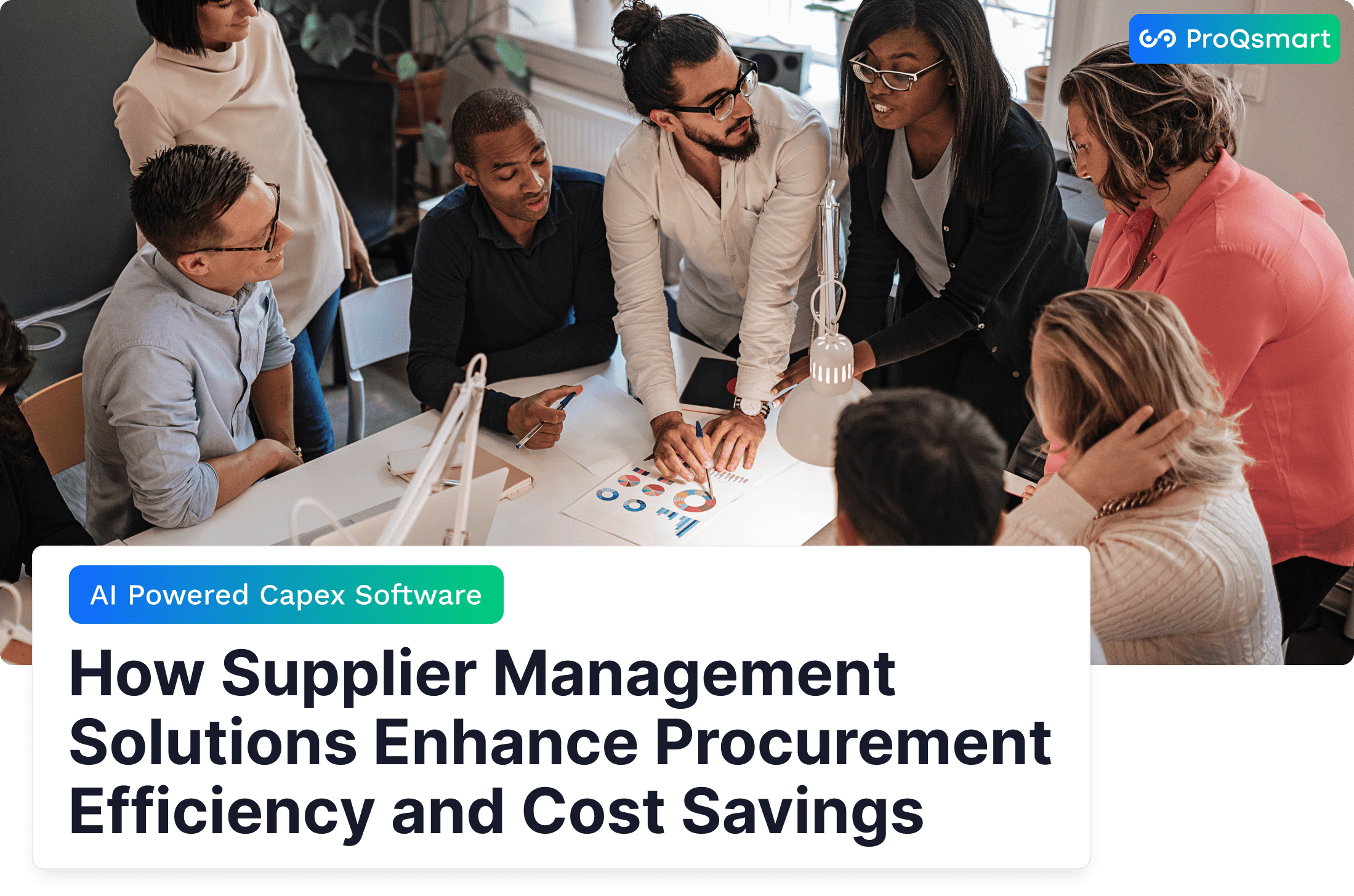Supplier management is the process of evaluating, onboarding, and monitoring vendors supporting your entire procurement process. This system, coupled with strict process controls, allows for seamless procurement and effective supply chain management. This includes finding competent suppliers, negotiating good contracts, and managing their performance in the pursuit of quality, cost, and delivery objectives.
Organizations face increasing challenges in navigating complex supply chains, complying with diverse regulations, and meeting fluctuating market demands. These complexities can lead to inefficiencies, higher costs, and operational risks if not addressed effectively.
Robust supplier management processes enable businesses to mitigate these risks, enhance operational efficiency, and achieve significant cost savings. By fostering collaboration and open communication with suppliers, organizations can build stronger partnerships that drive innovation and ensure sustainability. This article explores how supplier management solutions streamline procurement processes, improve supplier relationships, and unlock long-term value for businesses.
What is Supplier Management?
Supplier management is about managing the full supplier life cycle. It begins with
- Supplier selection,
- Continues with onboarding and performance management
- Ends with developing enduring partnerships.
Additionally, this methodology builds a deliberate and proactive system for ensuring that supplier capabilities and capacities align with organizational goals.
Strategic supplier management is key to driving down costs, improving risk mitigation, and maintaining business continuity. Through close collaboration and regular, often daily interactions, organizations can improve processes, eliminate administrative waste, and increase cycle times.
Challenges in Supplier Management

Organizations face numerous challenges in supplier relationship management that can obstruct speed, security, and collaboration. Issues such as inefficient processes and lack of visibility may lead to supply chain interruptions and strained relationships with strategic suppliers.
1. Manual Processes and Inefficiencies
When you’re still stuck on manual processes, it leads to mistakes, waits, and lack of communication. Consider supplier discovery — the sourcing process today can take months, with sourcing professionals needing to evaluate just a few dozen suppliers. This lack of efficiency drives up operational costs and delays schedules.
Transitioning to more automated systems is a way of significantly increasing that productivity. With ProQsmart’s AI-driven workflows, time-consuming tasks such as supplier pre-qualification and document management become seamless. Automating these key processes helps to find the time but improves quality through a higher degree of consistency and accuracy in data management.
2. Lack of Supply Chain Visibility
Poor visibility makes it nearly impossible to make proactive decisions required to avoid supply disruptions. Without real-time visibility, even a delay like 2–3 days on a shipment can turn into unhappy customers or even lost sales.
ProQsmart’s ERP integration uses smart technology to track supplier movement as it happens. This increases transparency down the entire supply chain, allowing companies to better predict and prepare for potential supply chain disruptions.
3. Communication Barriers with Suppliers
Ineffective communication builds an environment of distrust and lack of support from a supplier. Supplier communication is made even more difficult when there are different sourcing priorities within departments.
ProQsmart’s cloud-based collaborative platform increases transparency and collaboration allowing all stakeholders to communicate directly and resolve issues quickly and efficiently in real time. Consistent feedback loops and transparent lines of communication only help to fortify these relationships.
4. Difficulty in Tracking Supplier Performance
Keeping track of supplier performance can be a crucial task, especially without any tools. ProQsmart makes this process easy with performance scorecards and automated review facilitation.
This helps you stay compliant while providing insight into areas of improvement.
Benefits of Supplier Management Solutions

These collaborative benefits make effective supplier relationship management solutions a key component in any long-term procurement organization strategy designed to optimize operational excellence. Strengthening supplier relationships and increasing performance oversight enhance supply chain resilience. By centralizing valuable supplier information management data and mitigating risks at every step, the entire supply chain becomes more agile and responsive.
Improve Supplier Performance Tracking
Tracking supplier performance systematically is essential for maintaining quality, cost efficiency, and reliability. By implementing comprehensive performance metrics, businesses can assess supplier effectiveness across key areas such as delivery timelines, product quality, and cost adherence.
Solutions like ProQsmart’s supplier performance monitoring feature provide real-time dashboards, offering actionable insights into supplier compliance and contract fulfillment. Regular evaluations, supported by these tools, encourage continuous improvement while aligning supplier goals with organizational objectives.
For instance, a manufacturing firm using dashboards to monitor supplier performance saw a 15% reduction in delays, reinforcing the value of structured tracking.
Enhance Supplier Collaboration
Building better partnerships with suppliers accelerates growth and innovation for both parties. Joint problem-solving initiatives, accelerated by tools such as ProQsmart’s real-time collaboration functionalities, allow for easy communication and faster threats to success identification and resolution.
For example, enhanced transparency in communication helped a construction company negotiate better terms during material shortages. By building trust and mutual respect, suppliers stay committed and creative and partnerships are built for the long run, aligning supplier activities with all of your business objectives.
Centralize Data Management
A single source of truth through centralized data management reduces the risk of error, ensuring more informed decision-making. Creating one source of truth for all supplier data increases compliance, reduces duplication, and makes procurement more agile.
ProQsmart’s automated workflows and auditable sourcing data help make sure information is updating correctly, so businesses can stay safely clear of the risks posed by old data. Constantly auditing helps to ensure data stays current, which in turn helps improve supply chain visibility.
Mitigate Supply Chain Risks
Proactive risk management has never been more important than in today’s unpredictable markets. ProQsmart enriches supplier profiles with various risk metrics using supplier risk intelligence strategies such as sub-tier mapping.
This exercise exposes interdependencies that can endanger business continuity. These proactive measures, such as developing contingency plans and monitoring supplier performance, are crucial to protecting your business against potential disruptions.
Businesses armed with these kinds of solutions can pivot quickly to what’s needed, making sure they’re best positioned for supply chain resiliency.
How Technology Drives Procurement Efficiency by Supplier Management

Technology is at the forefront in helping organizations improve supplier relationship management and drive efficiency. By adopting tools like automation, artificial intelligence (AI), and analytics, enterprises can significantly streamline the supplier management process, reduce costs, and foster stronger supplier relationships.
Automate Processes and Reduce Workload
Automation removes the heavy load of monotonous tasks, allowing organizations to reallocate resources to far more strategic endeavors. Take automated data collection, which has been shown to minimize manual errors by 90%, saving thousands of hours per year.
Accelerated workflow automation increases data accuracy in processes such as order placement and invoice management. At the same time, tools such as ProQsmart make monitoring supplier performance and compliance with increased efficiency and efficacy.
This technology streamlines complicated workflows, brings procurement in step with budget goals, and promotes ongoing collaboration in real-time. Training staff on these tools is indispensable to discover the best efficiencies and find smooth integration into projects.
Leverage AI and Analytics for Insights
AI and advanced analytics are truly revolutionizing supplier management by providing them with meaningful, real-time insights. Tools such as ProQsmart’s AI-powered sourcing solution increase visibility into lead time and supply chain dependency information.
Predictive analytics helps to predict supplier issues so you can address them before they become a problem. With ProQsmart’s real-time data capabilities, businesses can evaluate suppliers with precision and confidence, ensuring that procurement objectives are achieved.
By shifting focus towards data-driven strategies, businesses can ensure better decision-making, improve supplier evaluation processes, and harness the potential for innovation.
Streamline Supplier Onboarding
Streamlined onboarding and offboarding processes are essential in order to achieve consistency and compliance. Consistent procedures backed by digital solutions make it easy for suppliers to register and provide the necessary documentation.
ProQsmart’s automation capabilities guarantee consistent and auditable sourcing data to improve transparency and tracking. An onboarding experience that prioritizes clear communication fosters the kind of confident relationship that seeds deeper collaboration down the line.
Actionable Strategies for Optimization
Foster Trust and Collaboration
Building trust immediately becomes the foundation of any successful supplier relationships. Open communication channels and regular touchpoints foster an environment of mutual investment and acknowledgment.
Collaborative contracting approaches ensuring strategies such as joint planning sessions and shared technology platforms promote collaboration, allowing your supplier base to better match with your goals. Long-term partnerships are advantageous because they save onboarding time, enhance service quality and performance, and create a vested interest in the long-term success.
For example, collaboratively developing sustainable packaging solutions with a packaging supplier can lower costs and improve sustainability.
Monitor and Improve Performance
Continual performance measurement via established KPIs keep suppliers aligned with goals and objectives. Metrics such as on-time delivery rates and quality defect percentages are valuable metrics that inform future action.
ERP systems make this process a lot easier by leveraging real-time visibility across supplier data, gap identification, and SLA compliance enforcement. Performance reviews, feedback loops, and constructive criticism are conflated with blame and punishment — but they don’t have to be!
Discussion of ongoing slippage in schedules, coupled with candid conversation, can result in a revision of the process that’s a win-win for both entities.
Leverage Data for Negotiations
Intelligent use of data is key to bolstering these negotiations. Understanding historical performance data drives these strategies, allowing identifying a greater need for concessions or more proactive improvements.
Being open about how you’ll be sharing your analytics builds trust and leads to better, mutually beneficial agreements. By leveraging platforms that centralize supplier performance metrics, you can simplify decision-making and improve deal outcomes to better align with your business objectives.
Integrate Risk Assessment
Proactive risk assessment is essential for supply chain resilience. Early identification of risks, like financial instability or non-compliance, prevents disruptions.
Tools that monitor compliance and track geopolitical factors provide critical insights, enabling swift mitigation actions. For example, diversifying suppliers in response to potential trade restrictions ensures continuity.
Promote Sustainable Sourcing
Sustainability must be the core of how companies approach supplier management. Moving beyond greenwashing, evaluating suppliers on environmental practices and social responsibility ensures alignment with corporate values.
Collaborating with environmentally responsible suppliers helps boost positive brand perception and avoid non-compliance with international regulations. For example, procuring semi-finished goods from producers who have certified reductions in their carbon emissions contributes to their value chain’s sustainability goals while lowering future costs.
Balance Diversity and Efficiency
Bringing diverse suppliers into the fold not only deepens innovation but strengthens overall resilience as well. By evaluating their performance, we can keep a check on the direct operational integrity and efficiency.
Deep and diverse supplier bases for responsiveness and flexibility proved crucial, as evidenced by the local suppliers who rapidly adapted when COVID-19 impacted supply lines. By balancing diversity with unforgiving quality metrics, they keep the wheels of government running effortlessly while paving the road to higher inclusivity.
Emerging Technologies in Supplier Management
Emerging technologies are giving organizations new opportunities to innovate their supplier management. They empower businesses to drive greater efficiency, visibility and trust across their supplier base.
These innovations not only streamline processes but enhance decision-making through real-time data and predictive analytics, making them indispensable in modern procurement strategies.
IoT for Real-Time Tracking
Today, IoT solutions are completely redefining how organizations use technology to monitor supplier performance in real-time.
Through sensors and other connected devices, businesses can more easily track inventory levels, monitor delivery times, and their overall supply chain visibility.
For example, IoT-enabled systems can immediately alert procurement teams to unexpected delays, giving them the opportunity to adjust proactively.
Available real-time data fuels digital twins, which mirror physical operations in a virtual environment to deliver actionable insights that help organizations optimize workflows.
By leveraging IoT, companies can become more responsive, keeping their supply chains adaptive to changing demands.
Cloud-Based Platforms
Cloud-based platforms allow project teams to have one source of supplier information, which fosters easier collaboration and communication.
These scalable systems provide increased flexibility, enabling businesses to manage supplier-related documents, contracts and performance metrics all in one location.
AI-powered platforms integrated into cloud environments can identify impending supply chain disruptions, informing more strategic decision-making.
When organizations adopt cloud-based solutions, they set themselves up to foster healthy supplier relationships while avoiding disruptions to the business.
Supplier Management Software Solutions
Selecting the right supplier management software is crucial for any organization aiming to enhance procurement efficiency and foster strong supplier relationships. A tailored solution ensures that you can manage supplier information, monitor risks, and streamline operations effectively.
Features to Look For
When evaluating supplier relationship management software, prioritize the following features.
- Tools to assess vendor compliance, delivery timelines, and quality metrics are indispensable. For example, Jaggaer uses AI to identify risks and opportunities.
- Consolidating vendor information ensures better accessibility and accuracy. ProQsmart is a clear leader because of its seamless interface when handling massive supplier data.
- Seamless connection with existing procurement systems avoids operational silos. By automating complex workflows and integrating directly with budget tracking systems, ProQsmart helps streamline and harmonize public procurement with financial goals and accountability.
- Easy navigation minimizes training time and boosts adoption rates.
Implementation Best Practices
Successful implementation begins with engaging stakeholders early to align goals and expectations. Training sessions ensure users maximize the software’s potential.
For example, ProQsmart powers highly efficient real-time collaboration and e-tendering to help you build supplier relationships.
Say, for instance, by ongoing evaluation—in the form of routine performance measurement and audits—keeping things working in the long-run and under changing conditions.
Conclusion
A culture of strong supplier management lays the groundwork for long-term success. By helping develop better relationships, reducing costs, and increasing efficiency, it now creates value. An area where tech can have immense impact is driving efficiencies and providing visibility into supplier performance. Leverage the best tools and strategies to identify risks upfront. This will put you in a position to win high-stakes negotiations and allow for consistent growth in your business operations.
Being first requires you to watch for new technologies and practices and respond to the market. Metrics are important for measuring progress, but smart negotiation can open doors for better deals. Supplier management is more than vendor management—it’s strategic supplier management that drives meaningful value to your business.
To maximize the potential of your procurement processes, consider leveraging ProQsmart’s advanced supplier management solutions. By making informed decisions today, you can set the stage for improved operational efficiency, enhanced collaboration, and substantial cost savings.
Schedule a demo with ProQsmart to explore how our tailored solutions can address your specific needs and drive long-term value for your organization.




